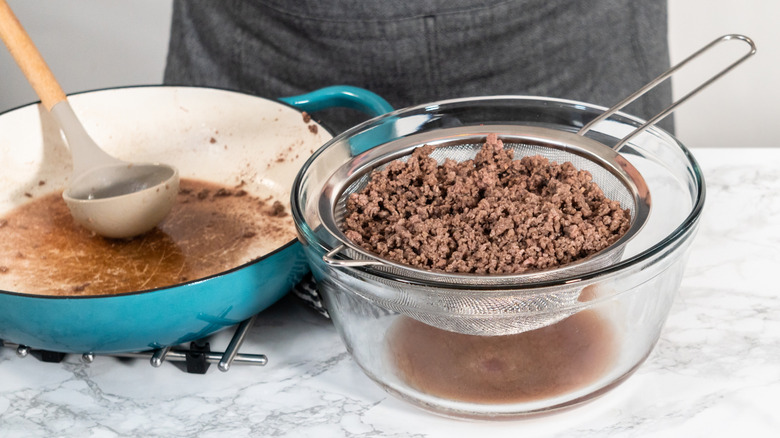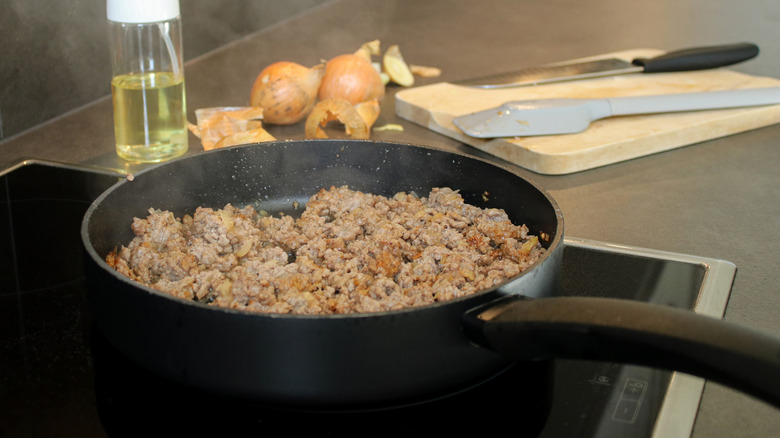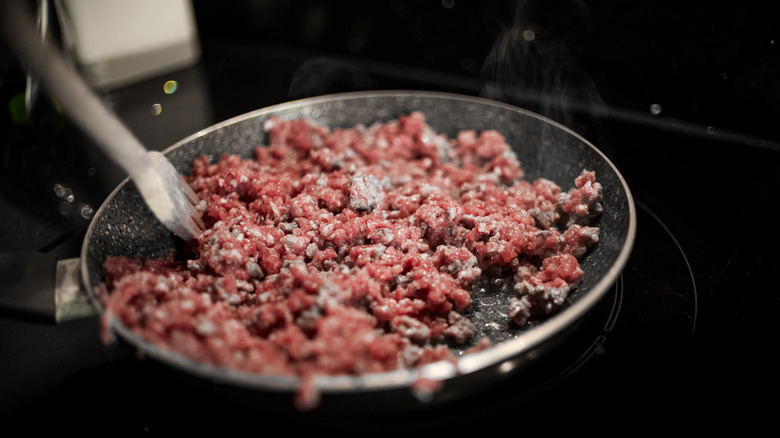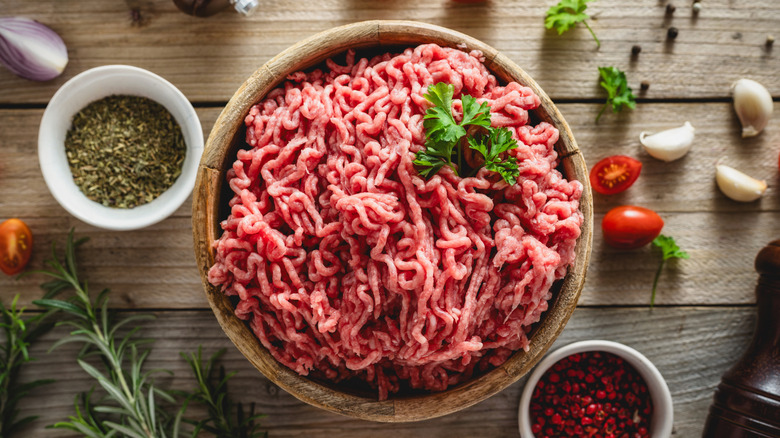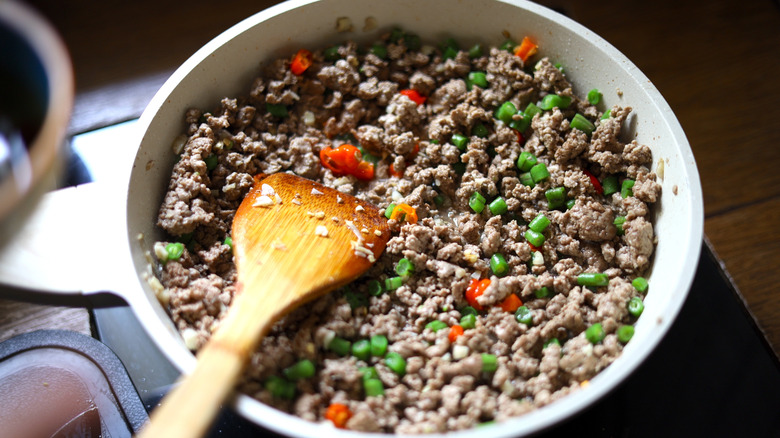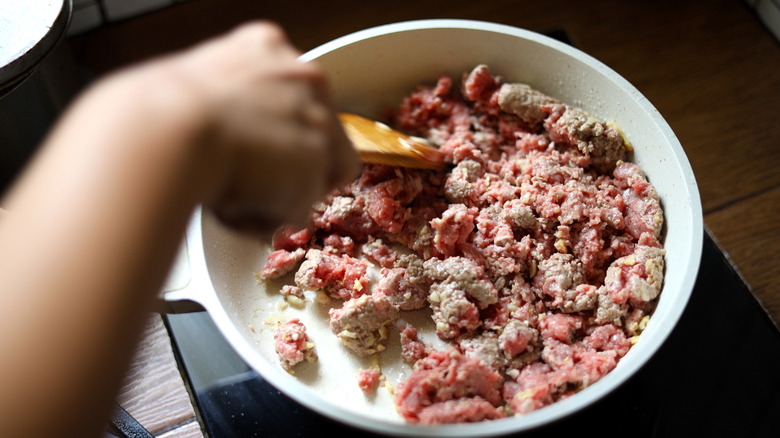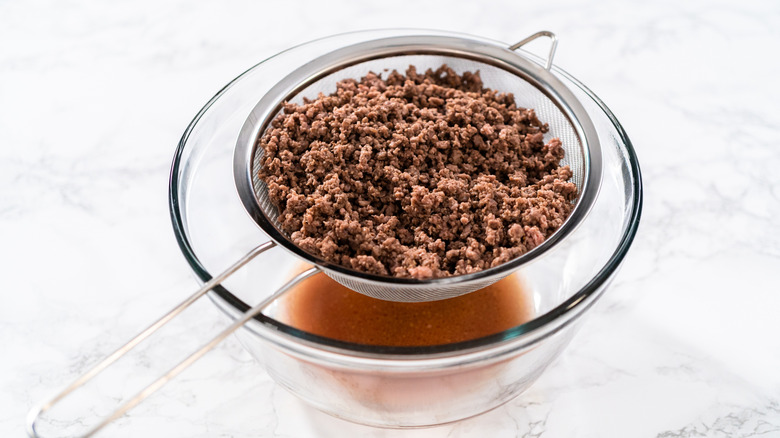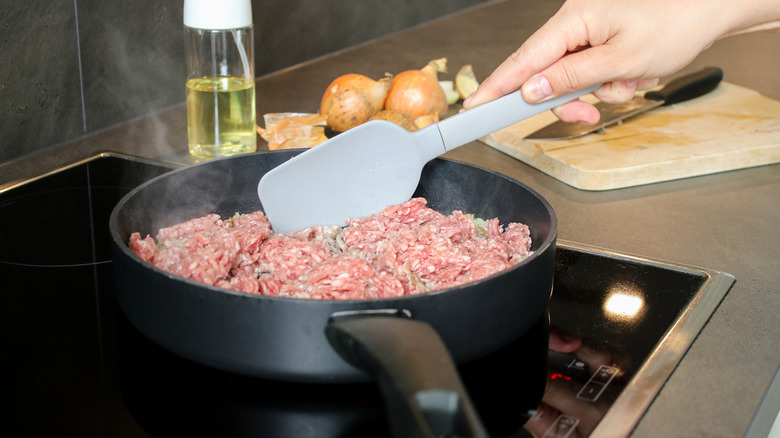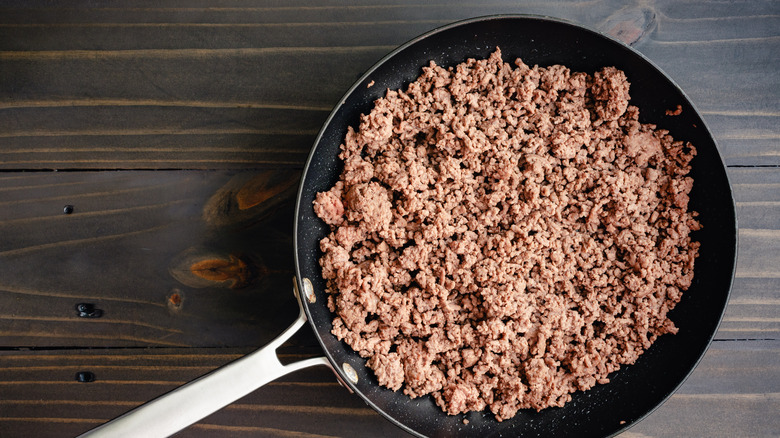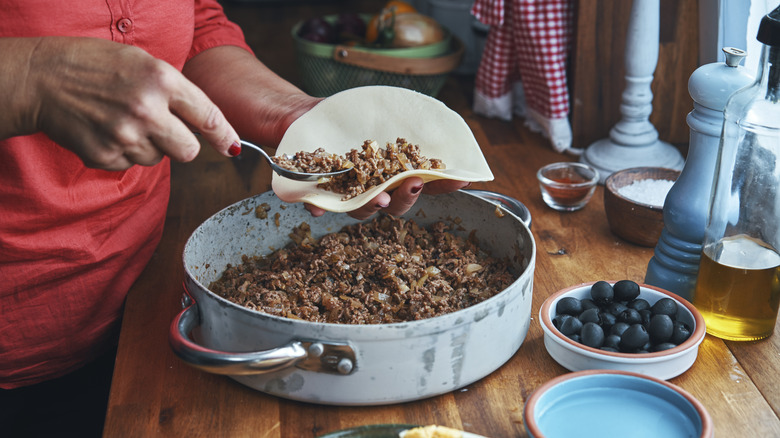Mistakes You're Making When Browning Your Ground Beef
Browning ground beef to perfection is an essential skill in the kitchen if you like meaty, hearty dishes — but it's surprisingly easy to make mistakes that can result in bland, soggy, or greasy meat that will ruin your entire recipe. In fact, the way you brown your beef makes a huge difference in flavor and texture, so it's absolutely necessary to get the process right from start to finish.
There are a few seemingly small but common slip-ups that can mess with the Maillard reaction (the fancy name for the browning process), from starting the process with a cold pan to over-stirring the beef. But the good news is that these issues are easy to avoid. That's why we're giving you a simple guide to highlight key cooking errors, and show you how a few simple changes can transform your ground beef to become the savory star in a diverse range of dishes.
Not treating ground beef with baking soda
It might sound like a strange science experiment, but treating your ground beef with baking soda before browning can completely change the results you get. Adding just a tiny amount of this kitchen staple to your ground beef is the secret to juicier, better-browned meat.
The method to this madness is that baking soda raises the pH level of the beef's surface, which helps prevent proteins from binding too quickly. When meat protein binds too fast, it squeezes out moisture, leaving it dry and rubbery. But with the baking soda treatment, moisture stays locked in, and browning happens more efficiently.
To try it at home, dissolve about ¼ teaspoon of baking soda in 1 tablespoon of water per pound of ground beef. Mix it with your meat and let it rest at room temperature for 15 to 20 minutes before cooking. This step may seem small, but it makes a noticeable difference — especially if you're working with leaner beef, which has a tendency to dry out faster. The beef will brown more quickly and stay more tender, with a deeper, richer flavor. As long as you use just a tiny amount of baking soda, it leaves no noticeable flavor, just better texture and sear. This is a little-known kitchen secret worth trying, particularly if you're tired of chewy meat and want a higher chance at obtaining your desired browning results.
Using the wrong type of pan
Not all pans work equally well when it comes to browning ground beef. The type of pan you choose can either help you achieve that desired texture or completely work against you.
When cooking, many people reach for a nonstick skillet out of habit — and this might seem rational with ground beef, as you don't want your meat to stick to the pan. Nonstick cookware is easy to clean, beginner-friendly, and forgiving ... but when it comes to searing meat, it's not the most ideal choice. Nonstick coatings aren't designed to withstand the higher temperatures required to achieve a beautiful sear. Another reason why you shouldn't use high heat with nonstick frying pans is that they could emit harmful fumes when overheated.
Instead, use a heavy-bottomed stainless steel or cast iron pan. Both of these types of cookware retain heat better than nonstick pans — and stainless steel, in particular, is prized for the fond it creates, which adds incredible depth to sauces and gravies. So if your ground beef consistently ends up pale and soggy, the issue might not be your cooking techniques or the beef you use — it could be your cookware. Upgrade your pan, and better results will follow.
Cooking ground beef in a cold pan
One of the quickest ways to ruin your chances at browning your ground beef properly is by starting with a cold pan. This might not seem like a huge issue, but starting off with an unheated pan prevents the beef from searing correctly. Instead of getting that caramelized, crust, your meat will release moisture too quickly and end up steaming. The reason this happens is very simple: When cold meat hits a cold surface, the pan's temperature drops further. It takes time for the pan to gradually heat back up, and by then, the beef already starts cooking in its own juices. Eventually, you'll have a pile of gray, bland meat that lacks texture and flavor.
To avoid this, always preheat your pan over medium-high heat before throwing in the ground beef. If you're not sure it's hot enough, use the water drop test: Simply add a bead of water into the empty pan, and if it dances around before evaporating, your pan is hot enough for searing meat. This one habit alone can transform your results.
Preheating your pan properly ensures that the surface is hot enough to trigger the Maillard reaction, which gives browned meat its signature taste and color. It also helps form a slight crust on the outside, which enhances texture and locks in juiciness. Skimping on preheating is like skipping the preheating step when baking — you can do it, but the results will never be as good.
Cooking ground beef at the wrong temperature
Temperature control is critical when it comes to browning ground beef, and getting it just right is nothing short of a science. Cook it too low, and you get gray, lifeless meat. Cook it too hot, and you risk burning the outside to a charred state before the inside is fully cooked.
For best results, you want to maintain a medium-high setting that's hot enough to achieve a good sear without drying the beef out or scorching it. The goal is to achieve the Maillard reaction without overly charring it. Also, remember that ground beef should be cooked to an internal temperature of 160 degrees Fahrenheit to be safe to eat. This is especially important for recipes where the beef is browned before being added to sauces or crowd-pleasing casseroles, as the meat may not reach that temperature again once mixed with other ingredients.
If your beef releases a lot of liquid right away and starts simmering, your pan likely isn't hot enough. On the flip side, if it smokes aggressively the moment the meat touches it, it's probably too hot. It is also recommended to preheat your pan thoroughly and cook the ground beef in batches to maintain the right temperature throughout the process. This may take a few extra minutes, but it's the difference between average and amazing beef.
Not dividing larger amounts of ground beef into small batches
When you're prepping a big meal — like a massive pot of Bolognese, or a taco meat recipe for the whole family — it's tempting to throw pounds of ground beef into the pan at once. But this, once again, leads straight to steaming instead of searing. Much like overcrowding, trying to brown too much beef at once makes it nearly impossible to get a good crust. The beef releases a large amount of moisture, which overwhelms the pan's ability to evaporate it. This drops the pan's cooking temperature, causing the meat to simmer in its own juices.
The fix is really simple: Just separate ground beef into smaller batches, allowing each portion of meat to develop proper browning before moving on to the next. This process may take a bit longer, but the final flavor is well worth it. You'll also have better control over the meat's texture. When you cook all the beef at once, the pieces often end up unevenly cooked, with some chunks being dry and overcooked, while others are still raw. Smaller batches ensure that every piece gets attention, and ensures that nice golden-brown color you're after. Plus, cooking ground beef in batches allows you to build up that rich, earthy fond at the bottom of the pan, which you can then deglaze with broth, wine, or tomatoes to create a deliciously thick sauce base.
Long story short: don't let efficiency cost you quality. Split your beef into smaller portions, and your skillet — and your recipe — will thank you.
Overcrowding the pan with ground beef
If you're in a rush, then tossing all your ground beef into the pan at once seems efficient and quick. But overloading your skillet is one of the fastest ways to turn browning into steaming. What happens is that when too much meat is added to the pan, it lowers the pan's surface temperature. The beef starts to release moisture, and with limited space, that moisture collects and turns your meat gray. Not only does this prevent a proper sear, but it also dilutes the flavor you're working so hard to build.
To avoid this, never overcrowd your pan. Cook ground beef in batches if you have a considerable amount of meat to work with. This might take a few extra minutes, but giving the meat space to breathe pays off in texture and taste. Each batch should sit in a single layer without overlapping. That allows each piece to make solid contact with the hot pan, giving it the best chance to brown instead of boil. The delicious seared bits stuck to the bottom of the pan, also known as the fond, only forms when the meat browns, not when it steams.
If you're making a dish like hearty beef chili hash, where ground beef is one of several ingredients, it might seem easier to overcrowd the pan. But avoid this at all costs. Another way to prevent overcrowding is to use a bigger pan, or a wok. Good things take time — and properly seared ground beef is absolutely worth it.
Immediately breaking up the ground beef into small pieces
It's practically a reflex — as soon as ground beef hits the pan, out comes the spoon to break it into crumbles. But doing this too early is a common mistake that can completely ruin your browning efforts. When you immediately break up ground beef into tiny pieces, you reduce the amount of meat in direct contact with the hot pan. That means less searing and more steaming, especially if you're also dealing with a little extra moisture or a cooler pan. Smaller pieces release moisture faster, so before you know it, the beef will be floating around in a puddle of juices.
Instead, try leaving the meat alone for a few minutes once it's in the hot pan. Let it sit undisturbed to allow a crust to slowly form on the bottom. Once it reaches your desired browning stage, you can flip it and break the meat up into parts. This technique creates more surface area for browning while letting the meat acquire all those nice flavors and caramelization. This method is especially helpful when making tacos, meat sauces, or sloppy joes, where richly browned beef is right at the core of the dish. You'll notice a big difference in depth and texture just by waiting those extra couple of minutes, making it taste more toasted and nutty. If you're used to stirring immediately, this method might feel unnatural at first — but trust the process.
Not draining the fat while cooking ground beef
Fat equals flavor, but too much fat can quickly turn your dish from rich and tasty to greasy, heavy, and full of unwanted juices. This tends to happen when cooking with higher-fat ground beef, like the 80/20 blend. If you don't drain the excess fat as the beef cooks, it pools in the pan and prevents effective browning. Instead of caramelizing, the meat ends up stewing in its own grease, losing both texture and intensity of flavor.
Once your beef is mostly browned, tilt the pan slightly and spoon off excess fat, or carefully pour it into a heatproof container. Alternatively, you can place a strainer over a bowl and place your cooked ground beef into it, before pressing the meat with a spoon for more thorough results. Just be sure to never pour the grease down the drain, as it can solidify in pipes and cause pretty annoying plumbing issues.
That said, not all fat is bad. In fact, some fat is needed to carry the ground beef's flavor, and give it that luscious shine and rich mouthfeel. For certain recipes, like meat sauces or hearty stews, you might want to keep a bit of the grease for later, or use it to sauté onions and garlic. In the end, it's all about balance. If you leave in too little fat, your dish may lack flavor, but too much fat could make it overly greasy. Knowing how much to drain, and when to do so, makes a huge difference in the final taste and texture of your meal.
Over-stirring the ground beef while cooking
Much like breaking up the meat too soon, over-stirring your beef can completely ruin the browning process. While it's tempting to keep things moving in the pan, all that motion disrupts the Maillard reaction and prevents the meat from properly searing.
Every time you stir, you're lifting the beef off the hot surface — interrupting contact that's needed for browning. Instead of developing those beautiful golden bits, your beef will cook unevenly and release more moisture than it should. Resist the urge to stir constantly, or even too often. After adding the beef to a preheated pan, let it cook undisturbed for a few minutes. Then flip sections in stages and let the other side cook. You'll build a crust and retain more flavor.
Of course, you'll still want to move the meat eventually to ensure even browning. The trick is to stir less, not never. It's all about timing and patience.
Not letting the beef rest before using it in a dish
Once your ground beef is beautifully browned, it might be tempting to toss it straight into a sauce, soup, or casserole. But not giving your beef a moment to rest can actually impact its flavor and texture — especially if you're incorporating it into a dish where the meat is supposed to take the spotlight.
When you remove ground beef from the pan, let it sit for a few minutes before mixing it into other ingredients. This brief resting period allows the juices to redistribute and settle. Resting also helps lock in the flavor you've worked so hard to develop. The beef's resting time gives the proteins a chance to relax slightly, maintaining a firmer texture and richer taste in the final dish.
This is something you'll want to take into account for recipes like tacos, stuffed peppers, or Bolognese, where beef is folded into a sauce or seasoning mix. You want your meat to retain its flavor and not get lost. Even just a few minutes of rest time on a plate lined with paper towels can make a noticeable difference. It's a small step, but it takes the overall quality of your meal to the next level — and ensures every bite tastes just right from start to finish.
Using the same utensils to cook and serve ground beef
Using the same spatula, spoon, or tongs to both cook and serve your ground beef can introduce harmful bacteria into your finished dish. When raw meat comes into contact with a utensil, that tool becomes contaminated. If you use it again after the meat has finished cooking without washing it, the utensil could transfer bacteria like E. coli or salmonella back onto your food. This is especially important when you're cooking ground beef, which has more surface area exposed to bacteria than whole cuts. Always use clean utensils and plates when handling cooked food to prevent cross-contamination.
To avoid these risks, use a different utensil to serve the beef once it's fully cooked, or wash the one you've been using thoroughly with hot, soapy water before using it for the finished dish. In a fast-paced kitchen, this step is easy to overlook, but food safety experts stress that safe cooking isn't just about hitting the right temperature — it's also about handling food properly.
The same rule applies for cutting boards and plates: never serve cooked meat on a dish that held it raw. All of this might seem obvious, but when it comes to keeping everyone at the dinner table safe, no precaution is too much.
